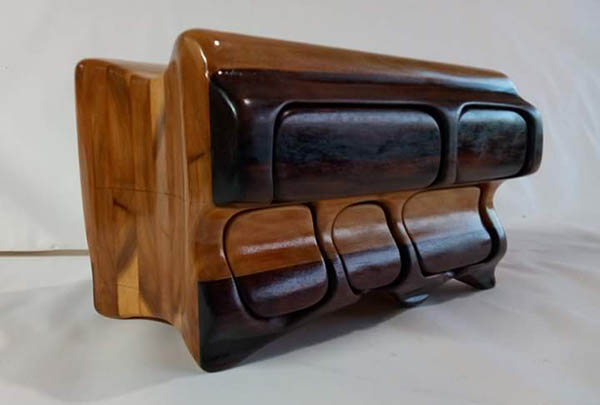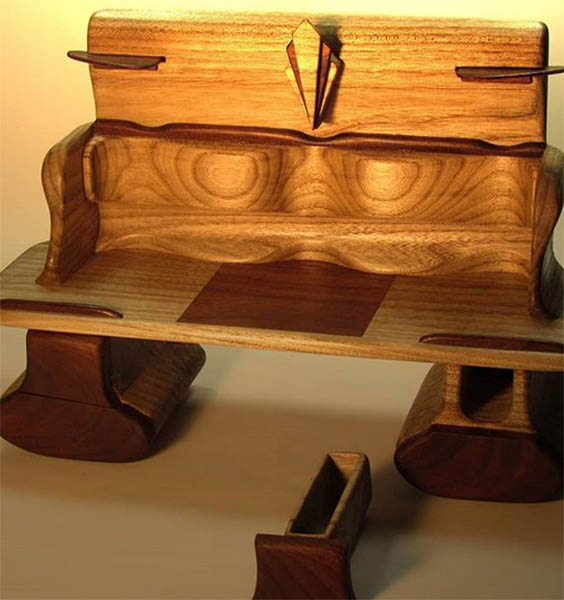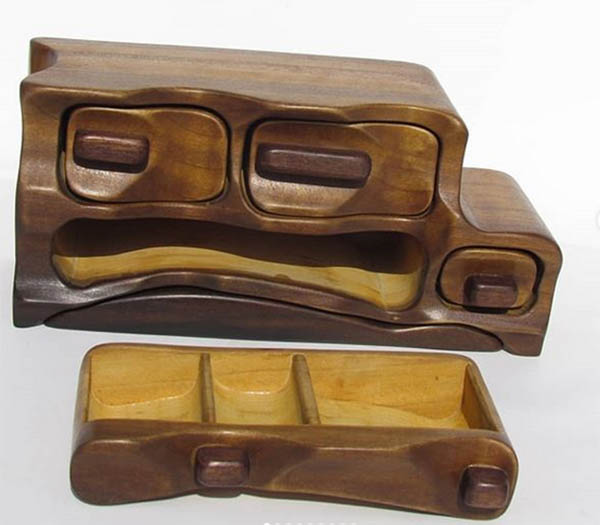
A few years ago, Ramon Gibbs talked about his band saw boxes with Woodworker’s Journal Weekly. He’s still making them, and is now focusing his woodworking on the specialty of what he has come to call “jewelry furniture.”
(He’s also still proud of being the first wood artist to contribute to the artists registry portion of the National September 11 Memorial and Museum. Ramon’s piece, U.S. Commemorative Wall Plaque, is included in the online database and virtual gallery of artistic work created in response to the events of September 11, 2001.)

Also a portrait artist, Ramon works closely with a few interior decorators and designers in the area of his Ohio home, offering both personalized portraits and the customizable jewelry furniture band saw boxes to their clients. “If you wanted something in a particular shade, or wood, or if you wanted it shaped in a certain way, like a heart, for example, you know; if you wanted like an image of a loved one or an animal or something embedded inside of it, you cannot get that from a Walmart or even a Macy’s for that matter,” Ramon said. “This is the garage woodworker that’s capable of doing that kind of thing.”

Ramon himself does do his woodworking out of his garage – which is why, he says, the cold months are a good time for him to have downtime that coincides with that of the interior decorators he works with. Many of his works have been commssions for them, while others, “there’s some that I actually made just for the hey of it,” he said.
He got started with the jewelry furniture after submitting a few pieces to a University of Cincinnati exhibition with the theme of “furniture.” Those boxes were styled to resemble various styles of desks, such as a rolltop desk and a secretary style desk.

“Everything’s fully functional” in those pieces meant to mimic furniture, Ramon said, noting that many of his pieces also have hidden drawers. Several others also have what he refers to as a “jewelry lay.” “The jewelry lay is simple a contour piece of wood,” Ramon said. “Many times, it’ll slide under the box itself, and it’s just something to lay the watch on, or the necklace or bracelet. Whenever possible, based on the design [of the box], I’ll make one with it.”

As for those designs, although they feature many curves, Ramon notes that, “ I don’t use roundover bits. All of my curves, transitional curves and compound curves, are actually done by hand. I may use a grinder to hog out; in different situations, I might break out a Dremel [rotary tool], but I can’t get it smooth with either one of them. I’ll get close with the band saw, but pretty much, I’m going in with hand.”
During that process, Ramon notes, “I actually only use primarily two grits of sandpaper: either a 60 or 80 on the coarse end and 120 to 150 on the fine end. It’s just simply a matter of how much pressure you push; you don’t need the whole full range of sandpaper to make it happen.”
Another factor in why he prefers not to use extremely fine sandpaper, Ramon said, is that he believes some of the stains he likes to use will not be absorbed into the wood.

For instance, for a couple of recent projects, pieces called “Memories” and “Yesteryear,” he used a staining process with vinegar and steel wool. “I purposefully did that because I wanted them to have more of an old, nostalgic look,” Ramon said. “What my technique is, I put [steel wool] in a container, a lidded container that has holes in the lid, because as it oxidizes, that steel wool is going to create a gas. And put straws down in it to keep the steel wool submerged because if it reaches top, that’s what will discolor it or create a rust or red cast. If the steel wool is held down under, it will keep a grayish or black cast. “
Ramon notes that he mixes “distilled vinegar and [distilled] water — the water that doesn’t have anything it it. You don’t need much and, after you put it on, literally within a few minutes, it begins to discolor. You could actually do multiple applications to get it darker and darker.”

In this case, Ramon applied two coats of the steel wool/vinegar stain to his pieces, then went back over them with the finer of his sandpaper grits, and finished up with a coat of shellac.
When it comes to the finishes he chooses or his woodworking in general, Ramon said, “you can create what’s considered a signature stamp, so that when somebody looks at your work, they recognize it before they see your branding iron or your name on it. But the other reason that you want to go that route is it makes it easier, and it makes it more enjoyable.
“When you can develop techniques, methods of doing things, then there’s much more enjoyment in it and you’re more apt to stick with it. Call me old-fashioned, but I think, had I not continued to do things the way I wanted to develop them, I probably would have given up.”





